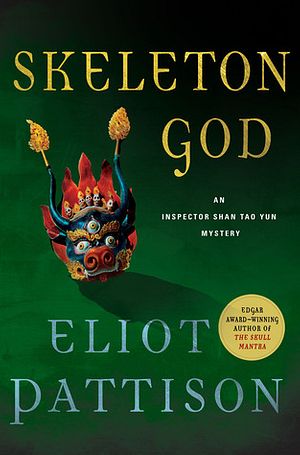Media coverage of Tibet tends to be bleak, from the Chinese government mounting security cameras around the childhood home of the current Dalai Lama to Buddhist monks setting themselves on fire to protest Beijing’s occupation of their ancient homeland. While it’s easy to digest these events from afar, the fact remains that some 2.2 million Tibetans are living in a perpetual state of occupation.
Skeleton God, the ninth novel in Eliot Pattison’s lauded Inspector Shan series, brings these headlines out of the realm of abstractions, and into the richly imagined Tibetan town of Yangkar. The latest book by Pattison, an international lawyer who has won the Edgar Award and Art of Freedom award for his fiction, offers an engrossing portrayal of the haunted history and harsh current realities of life in Tibet.
Little ink is spilled before the town’s constable, Shan Tao Yun, is swept into a web of intrigue, involving the reported assault of a nun by ghosts, and the discovery that a gilded Buddhist saint’s centuries-old tomb contains the bodies of a Chinese soldier killed 50 years ago and an American traveler who has just been murdered. Add a good dose of high-level corruption and a moving story about an attempted reunion of Tibetan refugees pulled apart by space and time, and you have the recipe for a gripping read.
As Shan begins to unravel the secrets behind the mysterious murders, he becomes entangled in a number of competing agendas. The Public Security Bureau wants to cover them up. Elements of the military want to tidy up the matter and get rid of Shan too. Meanwhile, locals furtively attempt to roll back the spiritual damage done on the haunted Plain of Ghosts, where the bodies are found in what has become a desecrated saint’s tomb. Inspector Shan is the only one who wants to discover the truth, which rocks Yangkar at its core.
The son of intellectuals who were victims of the Cultural Revolution, and formerly imprisoned in a hard labor camp himself (as is his son Ko), Shan’s remote posting is viewed as a hardship by comrades in Beijing. But Tibet changes him in unexpected ways. Far from the gaze of the capital, Shan strikes up a deep friendship with a wise old Tibetan named Lokesh, with whom he stargazes, wears a scorpion charm for protection from demons, and illegally gives recovered religious relics such as bronze dakinis back to the local Tibetans. Throughout the book, other Tibetan customs are elucidated in great detail, from pre-Buddhist salt sculptures linked to the shamanic Bon religion and the importance of blessing food for animals (in case they are reincarnated lamas), to the intricacies of demon hierarchies and the importance of getting an astrological death chart done just right.
Inspector Shan’s Tibetan sympathies are well founded, from both a historical and contemporary perspective. The book vividly depicts recollections of Tibetans being killed en masse by Mao’s Red Guard and the brutal system of reeducation, still ongoing, in which Tibetans are stripped of their names and given Chinese ones, then forced to embrace the ways of the motherland after letting go of the “Four Olds”: old habits, old customs, old ideas and old culture.
Pattison evokes a scene at the entrance to a reeducation camp called “New Awakening,” as follows:
“Trucks and buses disgorged Tibetans in tattered clothing along one side road lined with armed guards, and more waited at a gate on the other side to receive reclothed, renamed graduates for the long relocation ride into the bowels of China. The steel mills of Manchuria awaited, and the endless miles of chemical and textile factories in Guangzhou. The farther the relocation, recited Party planners, the more Chinese the subjects would become.”
This passage reads like it could have been lifted from a report written on the ground.
In a similar case of art and life overlapping, look no further than the Dalai Lama’s recent visit to Tawang monastery in the Indian state of Arunachal Pradesh. Beijing’s heated response to His Holiness’ April trip to the Tibetan enclave — set in a part of northeastern India that China views as an extension of Tibet — could have easily been a plot point in Pattison’s book. While a monastery visit may seem trivial, in the case of Tibet it is anything but.
“Tibet is a powder keg,” Inspector Shan says. “The fuse is long and slow-burning, but it is still a powder keg, ready for the final spark. That might be the death of the Dalai Lama.”
Indeed, speculation about the location of the Dalai Lama’s next incarnation, which the Chinese government claims to have authority over, was at the heart of the media chatter surrounding his visit to Tawang. Incensed, Beijing proceeded to rename six places closely linked with Tibetan Buddhism in the state. Similarly, the locals in Skeleton God defiantly scrawl “Yangkar” over the Chinese name “Buzhou” emblazoned on a sign planted by authorities at the entrance to Inspector Shan’s town.
Along with ample servings of suspense, history, culture, social issues, and rounded characters, this spirit of righteous defiance pervades Skeleton God, imbuing it with narrative heft and a sense of hope that Tibet’s soul may yet remain intact.

































